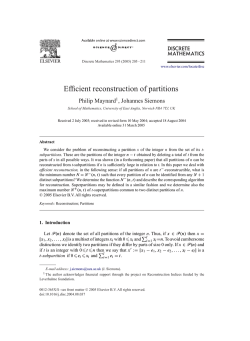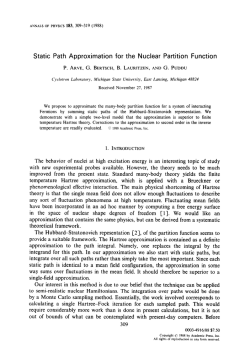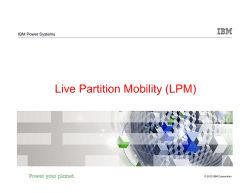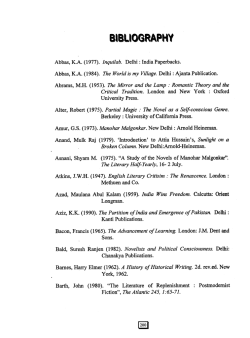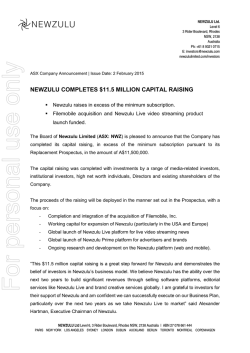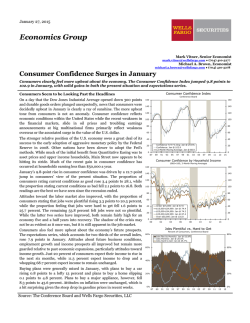
THE RELEVANT INTERNAL RATE OF RETURN
The Engineering Economist ISSN: 0013-791X (Print) 1547-2701 (Online) Journal homepage: http://www.tandfonline.com/loi/utee20 THE RELEVANT INTERNAL RATE OF RETURN Joseph C. Hartman & Ingrid C. Schafrick To cite this article: Joseph C. Hartman & Ingrid C. Schafrick (2004) THE RELEVANT INTERNAL RATE OF RETURN, The Engineering Economist, 49:2, 139-158, DOI: 10.1080/00137910490453419 To link to this article: http://dx.doi.org/10.1080/00137910490453419 Published online: 12 Aug 2010. Submit your article to this journal Article views: 488 View related articles Citing articles: 29 View citing articles Full Terms & Conditions of access and use can be found at http://www.tandfonline.com/action/journalInformation?journalCode=utee20 Download by: [UNAM Ciudad Universitaria] Date: 10 October 2016, At: 11:42 P1: KRE The Engineering Economist TJ1099-04 May 25, 2004 11:44 The Engineering Economist, 49:139–158, 2004 c Institute of Industrial Engineers Copyright ISSN: 0013–791X print / 1547–2701 online DOI: 10.1080/00137910490453419 THE RELEVANT INTERNAL RATE OF RETURN Joseph C. Hartman Ingrid C. Schafrick Department of Industrial and Systems Engineering, Lehigh University, Bethlehem, Pennsylvania, USA In this article we present a method for determining project acceptability in the presence of multiple internal rates of return. An internal rate of return is an interest rate that equates the present worth of a cash flow stream to zero. When unique, it provides valuable information about the return on the investment and is often viewed as a measure of efficiency. Unfortunately, this analysis is clouded when there are multiple internal rates of return, which can occur when a project is defined by a mixture of positive and negative cash flows. While many methods have been presented in the literature to deal with this problem, we believe ours to be unique in that it does not rely on the computation of another measure of worth, but rather, the identification of the relevant rate of return from the set of internal rates of return. We show that this rate always produces decisions consistent with present worth under the assumption that at least one real internal rate of return exists. In doing so, we provide new definitions of when a project is borrowing from, or loaning to, the firm. These definitions help in understanding the meaning of multiple internal rates of return, which is also discussed. The internal rate of return (IRR), mathematically defined as the interest rate that equates the present worth of a series of cash flows to zero, is and has been a popular measure of worth for purposes of project evaluation. When unique, it defines the return achieved by an investment (or true cost of a loan) and can often be viewed as a measure of efficiency. This Address correspondence to Joseph C. Hartman, Department of Industrial and Systems Engineering, Lehigh University, Bethlehem, PA 18015. E-mail: [email protected] 139 P1: KRE The Engineering Economist 140 TJ1099-04 May 25, 2004 11:44 J. C. Hartman and I. C. Schafrick explains its popular application, despite many of its well-documented problems. For decision-making purposes, the IRR can be compared to the discount rate for accepting and rejecting projects. The discount rate goes by many names in the literature, including the cost of capital, marginal growth rate, minimum attractive rate of return, and hurdle rate. We will use the term minimum attractive rate of return (MARR) in this article. To accept an investment project, the IRR must be greater than the MARR. To accept a loan, the IRR must be less than the MARR. When the IRR is equivalent to the MARR, then we are indifferent about the loan or investment opportunity. There are many documented troubles with respect to the IRR, including the difficulty in solving for the rate (when compared to present worth), as it often involves solving a high-order polynomial equation. This concern has been mitigated by the use of personal computers. Additional concerns include multiple IRRs, complex valued IRRs, and no IRR for a given project. In these situations, it is difficult to interpret the IRR (if one exists), and analysis is not straightforward. The other well-documented issue with the internal rate of return is that it requires mutually exclusive projects to be analyzed incrementally. In this article, we address the issue of multiple IRRs, as identified by Lorie and Savage (1955) in their seminal work. For multiple IRRs to occur, there must be “initial cash outlays, subsequent net cash inflows, and final cash outlays” (Lorie & Savage, 1955, p. 237). They illustrated this by way of an investment in an oil pump. The investment is described by an initial cash outlay followed by periods of net revenues and ending with a negative cash flow attributed to the removal and cleanup of the oil extracting location. Since there are many IRRs, it is unclear which IRR, if any, determines whether to invest in the oil pump. Therefore, based on this scenario, Lorie and Savage claim, “the rate-of-return criterion for judging the acceptability of investment proposals is ambiguous or anomalous” (Lorie & Savage, 1955, p. 237). Since their work, a number of methods have been proposed that define “equivalent” rates of return. (See, for example, Athanasopoulos, 1978; Baldwin, 1952; Lin, 1976; Solomon, 1956). As noted by Bernhard (1979), the “magnitudes of any of the rates of return can be difficult to interpret and hence easily misunderstood” (p. 166). These rates are often referred to as modified, external, or average rates of return. Teichroew, Robichek, and Montalbano (1965) classify projects as either investments, loans, or mixed investments and define a procedure to identify the return on invested capital (ROC). This value, when compared P1: KRE The Engineering Economist TJ1099-04 May 25, 2004 11:44 The Relevant Internal Rate of Return 141 to the MARR, determines whether a project should be accepted or rejected. Its decisions are consistent with present worth. Cannaday et al. (1986) describe a technique that determines which, if any, of the IRRs are relevant for investment projects. Hajdasinski (1987) extended their work to the case of a borrowing stream but illustrated that these techniques cannot deal with cash flows with duplicate roots, multiple relevant roots, or when the interest rate varies with time and when the MARR falls outside the range of real internal rates of return. Recently, Hazen (2003) defined a method where any IRR could be used to make the project selection decision. The method entails defining the investment balance of the cash flow stream for any IRR and analyzing it using the MARR. The method is consistent with present worth. In this article, we follow the work of Cannaday, Colwell, and Paley (1986) (and later Hajdasinski, 1987) by identifying the relevant internal rate of return from the set of internal rates of return. Thus, we do not require the computation of another measure of worth. Rather, we partition a project according to periods of borrowing and/or loaning as defined by the discount rate. From these definitions, the relevant IRR is defined when locating the MARR among the partitioned data. We believe this method allows for an analysis of the rate of return that is meaningful. We prove that the method is consistent with present worth, even in the presence of complex roots, under the assumption that at least one IRR is real. This article proceeds as follows: We define our notation and projects in the next section, and then we define our method for the case of real roots, followed by two examples. Then we expand the method to the case of complex roots, again followed by two examples. In the final two sections we prove the consistent relationship with present worth and attempt to shed light on the meaning of multiple roots. DEFINITIONS AND NOTATION Define a discrete cash flow stream as x0 , x1 , . . . , xn , where n ranges from one to the horizon, possibly infinity. The present worth of a project for an interest rate i, P W (i), is defined as: P W (i) = x0 + x1 x2 xn + + ··· + 1 2 (1 + i) (1 + i) (1 + i)n P1: KRE The Engineering Economist TJ1099-04 May 25, 2004 142 11:44 J. C. Hartman and I. C. Schafrick The future worth of a project (at time n) for an interest rate i, F W (i), is defined as: F W (i) = x0 (1 + i)n + x1 (1 + i)n−1 + x2 (1 + i)n−2 + · · · + xn The internal rate of return, defined as i ∗ , is the rate that equates the present worth, or equivalent future worth, to zero. Note that there may be multiple i ∗ . P W (i ∗ ) = n t=0 xt =0 (1 + i ∗ )t A conventional investment, as originally defined by Bierman and Smidt (1993), “is an investment that contains one or more negative cash outflows, followed by one or more positive cash inflows” (Bussey & Eschenbach, 1992, p. 188). A non-conventional investment is an investment that “intersperses the positive and negative cash flows” (Bussey & Eschenbach, 1992, p. 188). The traditional definition of a pure investment is one in which the firm has money invested in the project during every period of its life (Teichroew, Robichek, & Montalbano, 1965, pp. 155–156). The project’s investment balances (also referred to as unrecovered balances or project balances) are calculated at the internal rate of return, i ∗ , and are either zero or negative throughout the project’s life n. The firm does not borrow from the project at anytime during its life and it exactly recovers its investment at the end of the project’s life, earning interest at i ∗ in the interim periods (Bussey & Eschenbach, 1992, p. 189). For each period t, the investment balance is defined as: F Wt (i ∗ ) = t xm (1 + i ∗ )t−m ≤ 0 ∀t = (0, 1, . . . , n − 1) m=0 And at the end of the life n: F W (i ∗ ) = n xt (1 + i ∗ )n−t ≡ 0 t=0 Conversely, a pure loan has project balances that are always non-negative and the future worth is equal to zero at the internal rate of return. A mixed investment is an investment in which the firm has money invested in the project during some periods and the firm owes the project money during others (Teichroew, Robichek, & Montalbano, P1: KRE The Engineering Economist TJ1099-04 May 25, 2004 11:44 The Relevant Internal Rate of Return 143 1965, p. 156). A mixed investment does not qualify as a pure investment or a pure loan. Based on these definitions, a conventional investment can only be a pure investment, while a non-conventional investment can be either a pure or a mixed investment (Bussey & Eschenbach, 1992, p. 189). We do not dispute these definitions; however, we provide a different perspective. Define the slope of the P W (i) function according to its first derivative as: dPW(i) x1 2x2 nxn =− − − ··· − di (1 + i)2 (1 + i)3 (1 + i)n+1 Further, we define a project as a pure investment (from the perspective of the firm) if for all i in (−1, ∞): dPW(i) <0 di If one assumes that the interest rate represents the cost of capital, then this definition is intuitive as the value of an investment will decrease with an increase in the cost of capital. This is captured by the slope term, as any increase in the interest rate leads to a decrease in the present worth. We define a project as a pure loan (from the perspective of the firm) if for all i in (−1, ∞): dPW(i) >0 di Again, assuming the interest rate can be interpreted as the cost of capital, an increase in the cost of capital makes a loan (with a fixed cost of capital) more attractive (an increasing present worth) from the perspective of the entity providing the loan. A mixed investment is defined by both positive and negative first derivatives over the interest rate interval (−1, ∞). A firm is considered loaning to a project (or project is borrowing from the firm) when the first derivative of present worth with respect to i is decreasing. Thus, for a given interest rate i, a firm is loaning to a project if: dPW(i) 2x2 nxn x1 − − ··· − <0 =− 2 3 di (1 + i) (1 + i) (1 + i)n+1 P1: KRE The Engineering Economist 144 TJ1099-04 May 25, 2004 11:44 J. C. Hartman and I. C. Schafrick A firm is considered borrowing from a project (or a project is considered loaning to the firm) when the slope on the graph of the present value with respect to i is increasing, or: dPW(i) 2x2 nxn x1 − − ··· − >0 =− 2 3 di (1 + i) (1 + i) (1 + i)n+1 A maximum or minimum point of P W (i) occurs at ī. At this point, a project changes from an investing to a borrowing opportunity, or vice versa. The maximum or minimum occurs when: dPW(i) x1 2x2 nxn =− − − ··· − =0 2 3 di (1 + i) (1 + i) (1 + i)n+1 Clearly, with any change in the interest rate, the influence of cash flows change when computing the present worth. A sign change in the slope of the present worth function signifies that the influence of cash flows has changed enough to alter the direction of the function, thus changing it from a loaning to a borrowing opportunity, or vice versa. Note that at the values of ī, the project is defined neither as loaning nor as borrowing. These terms will be used to explain the new method throughout the rest of this article. MULTIPLE IRR SOLUTION PROCEDURE We now outline our procedure to determine project acceptability in light of multiple internal rates of return. For simplicity, we first introduce our method under the assumption that there are no complex roots and at least one real internal rate of return. 1. Using the cash flow stream, define the present worth as a function of the interest rate i and solve for all internal rates of return i ∗ . These can be found with any root-finding program (such as Maple, 2003) or for the case of real roots by graphing the function. 2. Take the first derivative of the present worth function and set it equal to zero to identify all maximum and minimum points, ī. For k internal rates of return, i 1∗ , i 2∗ , . . . , i k∗ there will exist k − 1 optimal points, ī 1 , ī 2 , . . . , ī k−1 . 3. Partition the graph at the maximum and minimum points, ī, and determine the investment type (borrowing or loaning) for each partition. For k internal rates of return there will exist k partitions and at most one IRR for each partition. P1: KRE The Engineering Economist TJ1099-04 May 25, 2004 11:44 The Relevant Internal Rate of Return 145 (a) The first partition is defined as (−1, ī 1 ). (b) The last partition is defined as (ī k−1 , ∞). (c) All other partitions are defined as (ī j , ī j+1 )∀ j = (1, 2, . . . , k − 2). Based on the earlier definitions of loaning and borrowing, the firm is loaning to a project (investing) if for all interest rates i in the partition: dPW(i) <0 di or borrowing if: dPW(i) >0 di Note that the direction of the slope (positive or negative) is fixed for a given partition. Further note that for the remainder of this article, we refer to partitions as either loaning or borrowing. This is from the perspective of the firm in that a firm is either loaning to, or borrowing from, the project. A loaning partition is equivalent to that partition of a project being defined as an investment while a borrowing partition is equivalent to that partition of a project being defined as a loan. 4. Locate the partition in which the MARR resides. (If the MARR is equal to an optimal point ī, then choose a partition on either side of the MARR. Either partition will reach the same conclusion.) The IRR that resides in the partition with the MARR is the relevant IRR, or IRR∗ . Compare the MARR to the IRR∗ as follows. (a) If the partition is defined by an investment project such that the firm is loaning to the project, then: • If the IRR∗ > MARR, accept. • If the IRR∗ = MARR, indifferent. • If the IRR∗ < MARR, reject. (b) If the partition is defined by a loan such that the firm is borrowing from the project, then: • If the IRR∗ < MARR, accept. • If the IRR∗ = MARR, indifferent. • If the IRR∗ > MARR, reject. We will illustrate this method with two examples from Hazen (2003). Example 1. Consider the cash flow stream (−1, 6, −11, 6). For discussion purposes, the present worth of the cash flow is graphed as a function of the interest rate in Figure 1. We now illustrate the decision procedure P1: KRE The Engineering Economist TJ1099-04 146 May 25, 2004 11:44 J. C. Hartman and I. C. Schafrick FIGURE 1. Present worth as a function of the interest rate for Example 1. with an MARR of 10%. 1. The present worth function is PW(i) = −1 + −11 6 6 + + 1 2 (1 + i) (1 + i) (1 + i)3 and the IRRs are i ∗ = 0, 1, and 2. 2. The first derivative is dPW(i) 6 22 18 =− + − 2 3 di (1 + i) (1 + i) (1 + i)4 and the minimum and maximum points are ī = 0.232408 and 1.4342582. 3. Partition the project as: (−1, 0.232408), (0.232408, 1.4342582), and (1.4342582, ∞). Based on the definition of loaning to a project, Partitions 1 and 3 are defined as loaning, and Partition 2 is defined as borrowing from a project as illustrated in Figure 1. This is readily obvious from the graph but can also be determined by computing the slope at an interest rate in each partition. P1: KRE The Engineering Economist TJ1099-04 May 25, 2004 11:44 The Relevant Internal Rate of Return 147 TABLE 1. Investment Decisions for All Possible MARRs for Example 1. Partition investment rate Relevant IRR Partition type −1 < i 0.232 0 Loaning 0.232 i 1.43 1 Borrowing i 1.43 2 Loaning MARR Decision −1 < MARR < 0 MARR = 0 0 < MARR 0.232 0.232 MARR < 1 MARR = 1 1 < MARR 1.43 1.43 MARR < 2 MARR = 2 MARR > 2 Accept Indifferent Reject Reject Indifferent Accept Accept Indifferent Reject 4. The MARR of 10% is found in Partition 1, which is a loaning partition. The IRR in Partition 1 is i ∗ = 0, which we define as IRR∗ . As the partition is loaning and the IRR∗ < MARR, we reject the project. Note the decisions for all relevant minimum attractive rates of return in Table 1, as illustrated in Figure 1, are consistent with present worth. This will be formalized later. Example 2. Consider the cash flow stream (−1, 4, −4). The present worth of the cash flow is graphed as a function of the interest rate in Figure 2. This is an interesting example, as there is only one internal rate of return. However, the project is a mixed investment, as the derivative FIGURE 2. Present worth as a function of the interest rate for Example 2. P1: KRE The Engineering Economist TJ1099-04 148 May 25, 2004 11:44 J. C. Hartman and I. C. Schafrick TABLE 2. Investment Decisions for All Possible MARRs for Example 2. Partition interest rate Relevant IRR Partition type −1 < i 1 1 Borrowing i 1 1 Loaning MARR Decision −1 < MARR < 1 MARR = 1 MARR = 1 MARR > 1 Reject Indifferent Indifferent Reject is both positive and negative for different interest rates, which clouds the analysis. The lone internal rate of return is defined as i ∗ = 1 with the only maximum point at ī = 1. This leads to partitions (−1, 1) and (1, ∞) with the MARR residing in the first partition. With a positive slope, this partition is defined as a borrowing partition, leading to the decision to reject the project as the MARR < IRR∗ . Decisions for all interest rates are given in Table 2. ACCOUNTING FOR COMPLEX ROOTS The above examples have only contained real roots. We now address how to deal with complex roots in our procedure. Steps 1, 2, and 3 are defined as previously, but the partitioning in Step 4 must be re-addressed as follows. 4. Identify all partitions from Step 3 that contain complex roots. “Collapse” these partitions such that the new remaining partitions contain only real roots. (Details of this procedure follow.) Once re-partitioning has been completed, each partition has one real IRR (assuming it had one real IRR in the feasible set). The investment type of the new partition is defined by the investment type of the original partition with the real IRR. As with previous terminology, the relevant internal rate of return is the real IRR that is contained in the same “new” partition as the MARR. Step 4 from the original procedure (now Step 5) remains as before such that the relevant IRR, investment type, and MARR are used to make the decisions. It might be helpful to elaborate on how the re-partitioning scheme works. Start with the first partition (−1, ī 1 ). If it contains a real IRR, proceed to the next partition. If it contains a complex IRR, collapse the partition such that the “new” first partition is (−1, ī 2 ). Now repeat the procedure. If the new partition contains a real IRR, proceed to the next P1: KRE The Engineering Economist TJ1099-04 May 25, 2004 11:44 The Relevant Internal Rate of Return 149 FIGURE 3. Present worth as a function of the interest rate for Example 3. partition (ī 2 , ī 3 ). Otherwise, collapse the partition such that the new first partition is (−1, ī 3 ). The procedure continues in this manner such that any original partition (ī j , ī j+1 ) with a complex root is collapsed into an original partition with a real root. We illustrate the analysis involving complex roots with the following two examples. Example 3. Our third example considers the cash flow stream (−1, 6, −11, 6.5) with its present worth function defined in Figure 3. 1. The present worth function is PW(i) = −1 + −11 6.5 6 + + 1 2 (1 + i) (1 + i) (1 + i)3 and the IRRs are i ∗ = 2.19 and 4.0426 ± 0.2544i. (Do not confuse the use of the letter i, which identifies a complex number with the interest rate.) 2. The first derivative is dPW(i) 6 22 19.5 =− + − di (1 + i)2 (1 + i)3 (1 + i)4 and the minimum and maximum points are ī = 0.5 and 1.167. P1: KRE The Engineering Economist TJ1099-04 150 May 25, 2004 11:44 J. C. Hartman and I. C. Schafrick TABLE 3. Investment Decisions for All Possible MARRs for Example 3. Partition interest rate i > −1 Relevant IRR Partition type 2.19 Loaning MARR Decision −1 < MARR < 2.19 MARR = 2.19 MARR > 2.19 Accept Indifferent Reject 3. Partition the project as: (−1, 0.5), (0.5, 1.167), and (1.167, ∞). 4. Due to the existence of complex roots in partitions one and two, we must re-partition the graph such that each partition has one real root, or (−1, ∞). While the slope of the new partition does not have a constant sign, we define it as loaning in this instance because that is the definition of the original partition with the single real root. (We will address this issue again later.) 5. Since it is a loaning partition, we accept the project as the relevant IRR of 2.19 is greater than the MARR 0.10. Decisions for all possible MARRs are given in Table 3. Example 4. The final example, with the present worth function illustrated in Figure 4, is defined by the cash flow stream (0.25, −40, 65, −1, −25, −49.5, 40). We find that i ∗ = −0.2616, 0.1319 ± 0.5393i, and 157.36. In this case, two of the four internal rates of return are complex. The optimal points are ī = −0.1222, 0.5624, and FIGURE 4. Present worth as a function of the interest rate for Example 4. P1: KRE The Engineering Economist TJ1099-04 May 25, 2004 11:44 The Relevant Internal Rate of Return 151 TABLE 4. Investment Decisions for All Possible MARRs for Example 4. Partition interest rate Relevant IRR Partition type −1 < i 1.6592 −0.2616 Loaning i 1.6592 157.36 MARR −1 < MARR < −0.2616 MARR = −0.2616 −0.2616 < MARR 1.6592 Borrowing 1.6592 MARR < 157.37 MARR = 157.37 MARR > 157.36 Decision Accept Indifferent Reject Reject Indifferent Accept 1.6592. We create the following partitions: (−1, −0.1222), (−0.1222, 0.5624), (0.5624, 1.6592), and (1.6592, ∞) and define each as loaning, borrowing, loaning and borrowing, respectively. As the complex roots are found in partitions 2 and 3, we re-partition, creating the following new partitions: (−1, 1.6592), and (1.6592, ∞). The new partitions are defined as loaning and borrowing, respectively, according to the original partitions with real roots. The MARR is located in partition one with i ∗ = −0.2616. With the IRR∗ < MARR and the partition defined as loaning, we reject the project. The results in Table 4 are consistent with present worth. In the case where no real internal rates of return exist, we cannot use this method of analysis to determine project acceptability because there does not exist an IRR to compare to the MARR. (This would also be a problem for traditional IRR analysis, which is a subset of this analysis.) Note that the case in which there are no real IRRs means that the PW function never crosses the interest rate axis. Thus, the PW is always positive or always negative, leading to a trivial decision in either case. EQUIVALENCE TO PRESENT WORTH The figures and tables in the previous section have illustrated that our method is consistent with present worth for decision-making purposes. We formalize those concepts now. Lemma 1: Under the assumption that at least one real IRR exists, there is at most one real root per partition. Proof: For the case of real IRRs, by definition, the slope between any two consecutive optima is either positive or negative and does not change. Thus, the present worth function can equal zero at most once in this interval, defining at most one IRR. P1: KRE The Engineering Economist 152 TJ1099-04 May 25, 2004 11:44 J. C. Hartman and I. C. Schafrick For the case including complex IRRs, by construction, each partition is defined by having one real root. Theorem 1: Project accept and reject decisions made with the relevant IRR are consistent with those using present worth for any given MARR. Proof: According to the present worth decision criterion, if the PW(MARR) > 0, then the project should be accepted. Thus to prove consistency, if the PW(MARR) > 0, either: i ∗ < MARR and dPW(i) >0 di for i = MARR i ∗ > MARR and dPW(i) <0 di for i = MARR or: must be true. Note that by our method, a partition is defined by either a positive or negative slope, and by Lemma 1 a partition has at most one real root. By definition, PW(i ∗ ) = 0. Assume d PdiW (i) > 0. For any i > i ∗ , the present worth remains positive. Thus, if the i ∗ < MARR, the PW(MARR) > 0. Assume d PdiW (i) < 0. For any i < i ∗ , the present worth remains positive. Thus, if the i ∗ > MARR, the PW(MARR) > 0. According to the present worth decision criterion, if the PW(MARR) < 0, then the project should be rejected. Thus to prove consistency, if the PW(MARR) < 0, either: i ∗ > MARR and dPW(i) >0 di for i = MARR i ∗ < MARR and dPW(i) <0 di for i = MARR or: must be true. (i) > 0. For any i < i ∗ , By definition PW(i ∗ ) = 0. Assume dPW di the present worth remains negative. Thus, if the i ∗ > M A R R, the (i) PW(MARR) < 0. Assume dPW < 0. For any i > i ∗ , the present worth di ∗ remains negative. Thus, if the i < MARR, the PW(MARR) < 0. P1: KRE The Engineering Economist TJ1099-04 May 25, 2004 11:44 The Relevant Internal Rate of Return 153 Note that this argument also holds in the case of complex roots. Complex roots always occur in pairs and thus, the present worth slope sign changes twice in their presence without crossing the x-axis (a real root). Thus, the sign of the present worth slope in the partition preceding a complex root and the sign of the slope in the partition after the second (companion) complex root are always the same. Therefore, the present worth function does not change sign in the presence of complex roots and the decision does not change when this area is “collapsed” in the re-partitioning procedure. Thus, according to Theorem 1, the procedure described produces decisions that are consistent with present worth. INTERPRETING MULTIPLE IRRs Now that the method of determining project acceptability in light of multiple internal rates of return (assuming at least one is real) has been defined, the question remains as to whether multiple rates of return have meaning. The popularity of the IRR as an investment decision criterion is clear when there is one rate of return, as the rate truly defines the return earned (or interest paid) on an investment. It can also be viewed as a measure of efficiency in this manner. However, these interpretations are no longer clear with multiple rates of return. It should be straightforward as to why multiple roots occur. They are the result of a change in the interest rate causing individual cash flows’ influences on present worth to change. Figure 5 illustrates the present worth as a function of the interest rate for each individual cash flow from Example 1 with flows (−1, 6, −11, 6). From this graph, we can better understand what is occurring over the interest rate spectrum. The data for the graph is also given in Table 5 as the present worth curve is extremely flat over the interesting range of interest rates, making the graph difficult to read. We arbitrarily begin our analysis with a zero percent interest rate. At this rate, the sum of the inflows and outflows negate each other, leading to a present worth of zero. Increasing the interest rate, the influence of the final cash flow ($6) diminishes more quickly than the other cash flows, causing a decreasing present worth (signaling an investment opportunity) that becomes negative. However, at 23.2%, the influence of the −$11 cash flow is overcome by the positive cash flows, and as the interest rate continues to increase the present worth of the cash flow series increases (signaling a loan opportunity). This continues until the rate of 143% is reached, at which time the influence of the $6 cash flow P1: KRE The Engineering Economist 154 TJ1099-04 May 25, 2004 11:44 J. C. Hartman and I. C. Schafrick FIGURE 5. Present worth of individual cash flows from Example 1. at time one is overcome and the negative time zero cash flow dominates, as the present worth decreases, approaching the investment cost of −$1 as the interest rate goes to infinity. Walking through this example reiterates the fact that the cash flows cannot be defined as borrowing or loaning opportunities unless the interest rate is specified, as it defines the influence of each individual cash flow on the slope of the present worth function. In this example, the cash flows truly define three different opportunities, depending on the discount rate used by the evaluator. For example, if a company uses a rate of 15%, then they would reject this as an investment opportunity. If a different company had a discount rate of 25%, they would reject the project as a loan opportunity. In the described method, we partitioned the present worth function according to different interest rates. In each region, the type of investment is fixed, as the slope is either increasing or decreasing. Thus, each partition defines an investment (loaning or borrowing) to be analyzed. While we traditionally think that a cash flow series defines an investment (or borrowing) opportunity, it is truly the cash flows and the interest rate that define the opportunity. If an investment cannot be defined exogenously from the interest rate, then a series of cash flows may define numerous investments. Given a cash flow series and a MARR, the relevant rate of return defined in this article is a valid rate of return for analysis and can be interpreted much in the same way that a unique IRR is analyzed. This recognition of a MARR to identify the relevant IRR can be avoided in the case of a unique, real IRR, because it is the relevant IRR, using our terminology, for all possible MARRs. Despite this fact, the IRR still requires the definition of a MARR for project accept/reject decisions. This is because the IRR P1: KRE The Engineering Economist TJ1099-04 May 25, 2004 11:44 The Relevant Internal Rate of Return 155 TABLE 5. Present Worth for Each Individual Cash Flow for Example 1. i% −1 6/(1 + i)1 −11/(1 + i)2 6/(1 + i)3 P W (i) dPW(i)/di −20 −10 0 10 20 30 40 50 60 70 80 90 100 110 120 130 140 150 160 170 180 190 200 210 220 230 240 250 260 270 280 290 300 −1.00 −1.00 −1.00 −1.00 −1.00 −1.00 −1.00 −1.00 −1.00 −1.00 −1.00 −1.00 −1.00 −1.00 −1.00 −1.00 −1.00 −1.00 −1.00 −1.00 −1.00 −1.00 −1.00 −1.00 −1.00 −1.00 −1.00 −1.00 −1.00 −1.00 −1.00 −1.00 −1.00 7.50 6.67 6.00 5.45 5.00 4.62 4.29 4.00 3.75 3.53 3.33 3.16 3.00 2.86 2.73 2.61 2.50 2.40 2.31 2.22 2.14 2.07 2.00 1.94 1.88 1.82 1.76 1.71 1.67 1.62 1.58 1.54 1.50 −17.19 −13.58 −11.00 −9.09 −7.64 −6.51 −5.61 −4.89 −4.30 −3.81 −3.40 −3.05 −2.75 −2.49 −2.27 −2.08 −1.91 −1.76 −1.63 −1.51 −1.40 −1.31 −1.22 −1.14 −1.07 −1.01 −0.95 −0.90 −0.85 −0.80 −0.76 −0.72 −0.69 11.72 8.23 6.00 4.51 3.47 2.73 2.19 1.78 1.46 1.22 1.03 0.87 0.75 0.65 0.56 0.49 0.43 0.38 0.34 0.30 0.27 0.25 0.22 0.20 0.18 0.17 0.15 0.14 0.13 0.12 0.11 0.10 0.09 1.03 0.32 0.00 −0.13 −0.17 −0.16 −0.14 −0.11 −0.08 −0.06 −0.03 −0.01 0.00 0.01 0.02 0.02 0.02 0.02 0.02 0.02 0.01 0.01 0.00 −0.01 −0.02 −0.02 −0.03 −0.04 −0.05 −0.06 −0.07 −0.08 −0.09 −10.3516 −4.6639 −2.0000 −0.7240 −0.1157 0.1611 0.2707 0.2963 0.2808 0.2466 0.2058 0.1642 0.1250 0.0895 0.0581 0.0307 0.0072 −0.0128 −0.0298 −0.0440 −0.0560 −0.0659 −0.0741 −0.0808 −0.0862 −0.0906 −0.0940 −0.0966 −0.0986 −0.1000 −0.1009 −0.1014 −0.1016 is a relative measure of worth, not an absolute measure of worth, such as present worth. The difference with multiple rates of return is that one cannot find the internal rate of return and then compare it to the discount rate. Rather, one must specify the discount rate, identify the relevant rate of return, and then make a comparison. This may seem like a subtle difference, but it may have far-reaching consequences. Consider the approach for identifying the MARR (in P1: KRE The Engineering Economist 156 TJ1099-04 May 25, 2004 11:44 J. C. Hartman and I. C. Schafrick constrained capital budgeting) in which projects are ranked according to their IRRs and the MARR is identified as the rate at which projects can no longer be funded due to resource limitations (assuming projects are accepted in ranked order). Following our reasoning, the MARR must be identified before identifying the relevant rate of return. Thus, any method that presumes to use the internal rate of return without knowledge of the MARR would appear to be infeasible. This, again, is due to the nature of the IRR being a relative measure of worth, rather than an absolute measure, as present worth. Fortunately, this “issue” is avoided for the case of a unique IRR because, as noted earlier, it is the relevant IRR for all possible MARR values. It should, however, give one pause when applying this method. As noted by Hazen (2003), it is difficult, if not impossible, to interpret complex internal rates of return. In our partitioning scheme, they are removed from analysis and we assume that a project’s status (loaning or borrowing) does not change in the new partition. We can say this because the presence of complex roots means the slope of the present worth has changed, but not significantly enough to produce a real root (cross the x-axis). Rather, by definition of a complex root, the slope must change again before the x-axis is crossed. Unfortunately, while our method of collapsing partitions allows for correct analysis in the presence of complex roots, it muddles our definition of a project being loaning or borrowing according to the slope of the present worth. This might signal that complex roots do have meaning, although we do not have an interpretation at this time. CONCLUSIONS AND FUTURE RESEARCH In this article, we present a method for determining project acceptability when multiple IRRs are present. Like most other methods, this technique is consistent with present worth. However, unlike other methods, this method considers the MARR when determining the relevant IRR, which determines project suitability. The method is illustrated with four different examples and shown to be viable for any problem in which there is at least one real root. When complex roots are encountered, only the real roots are used for project acceptability decisions. We use the term “relevant IRR” in this article as we identify which rate, from the set of real IRRs, is relevant and should be used in subsequent analysis. As we require an external rate to define the relevant IRR, a reviewer correctly noted that the relevant IRR is no longer “internal.” We acknowledge that here but keep the name, stressing that this procedure P1: KRE The Engineering Economist TJ1099-04 May 25, 2004 11:44 The Relevant Internal Rate of Return 157 does not define a new rate of return, but merely chooses one from the set of IRRs. We also attempt to shed light on the meaning of multiple IRRs. We argue that a series of cash flows does not define an investment opportunity (loaning or borrowing). Rather, this cannot be determined without a discount rate. As the case of having a single IRR is merely a special case of ours, it would appear to discourage the use of IRRs for determining the MARR, as the relevant IRR cannot be determined exogenously from the MARR. This problem is mitigated in the case of a unique IRR, as it is the relevant rate of return for all possible MARRs. While the proposed method is consistent with present worth when at least one real root is present, we echo the sentiments of previous scholars that advocate the use of present worth in these situations (multiple IRRs). Identifying the relevant IRR is not complicated, but it is much more involved than identifying the present worth of the cash flows given the discount rate. The goal of this article is to shed more light on the meaning of multiple IRRs and their relation to loan and investment opportunities. We also believe that this information can be useful for staunch advocates of the IRR. As for future research, it would be interesting to more formally tie this method to the methods of Hazen (2003) and Teichroew, Robichek, and Montalbano (1965). Perhaps the link may lie in investment balances, but this will not be trivial as the method here differentiates a project according to the discount rate, not time. Finally, it would be interesting to attribute some formal meaning to complex IRRs because, as noted earlier, they cause interpretation problems with respect to the type of investment being analyzed. ACKNOWLEDGMENT This research was supported in part by the National Science Foundation grant number DMI-9984891. We would like to thank two anonymous referees for their constructive comments which improved the readability of the manuscript. REFERENCES [1] Athanasopoulos, P.J., “A note on the modied internal rate of return and investment criterion.” The Engineering Economist, Vol. 23, No. 2, 1978, pp. 131–133. P1: KRE The Engineering Economist 158 TJ1099-04 May 25, 2004 11:44 J. C. Hartman and I. C. Schafrick [2] Baldwin, R.H., “How to assess investment proposals,” Harvard Business Review, Vol. 27, No. 3, 1959, pp. 98–104. [3] Bernhard, R.H., “Modied rates of return for investment project evaluation—A comparison and critique,” The Engineering Economist, Vol. 24, No. 3, 1979, 161– 167. [4] Bierman, Jr. H. and S. Smidt, The capital budgeting decision (8th ed.). New York: MacMillan, 1993. [5] Bussey, L.E. and T.G. Eschenbach, The economic analysis of industrial projects (2nd ed.). New York: Prentice-Hall, 1992. [6] Cannaday, R.E., P.F. Colwell, and H. Paley, “Relevant and irrelevant internal rates of return,” The Engineering Economist, Vol. 32, 1986, pp. 17–38. [7] Hajdasinski, M.M. “On relevant and irrelevant internal rates of return,” The Engineering Economist, Vol. 32, 1987, pp. 347–353. [8] Hazen, G.B., “A new perspective on multiple internal rates of return,” The Engineering Economist, Vol. 48, 2003, pp. 31–51. [9] Lin, S.A.Y., “The modifed internal rate of return and investment criterion,” The Engineering Economist, Vol. 21, No. 4, 1976, pp. 237–247. [10] Lorie, J.H. and L.J. Savage, “Three problems in rationing capital,” The Journal of Business, Vol. 28, No. 4, 1955, pp. 228–239. [11] Maplesoft, Maple 9.0. Waterloo, Canada: Maplesoft, 2003. [12] Solomon, E. “The arithmetic of capital budgeting decisions,” Journal of Business, Vol. 29, 1956, pp. 124–129. [13] Teichroew, D., A.A. Robichek, and M. Montalbano, “An analysis of criteria for investment and nancing decisions under certainty,” Management Science, Vol. 13, No. 3, 1965, pp.150–179. BIOGRAPHICAL SKETCHES JOSEPH C. HARTMAN is an associate professor in the Department of Industrial and Systems Engineering at Lehigh University. He received his Ph.D. (1996) and M.S. (1994) in Industrial Engineering from the Georgia Institute of Technology and B.S. in General Engineering from the University of Illinois at Urbana-Champaign (1992). He is an active member of ASEE, IIE, and INFORMS and currently serves as an editor of The Engineering Economist. He won the 2000 Eugene L. Grant Award from ASEE. INGRID SCHAFRICK is a Corporate Value Consultant for Standard and Poors in New York City. She received her B.S. in Industrial Engineering in 2002 from Lehigh University. After achieving Alpha Pi Mu and Tau Beta Pi honors, she was named a Presidential Scholar to pursue her M.S. in Industrial Engineering from Lehigh University (2003). She has previously worked for IBM and Lutron Electronics.
© Copyright 2025


